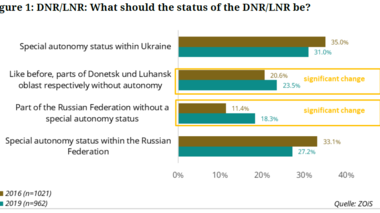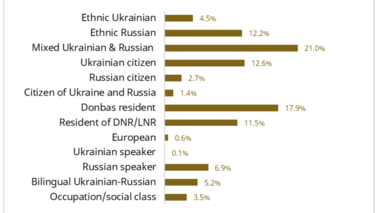Donbas: Majority wants DNR/LNR to be part of Ukraine
A survey among the population in Donbas shows that a majority on both sides of the front line prefers for the DNR/LNR to remain part of Ukraine. While opinions on the future status are diverse, the option to be part of Ukraine without an autonomous status has even gained in popularity in the non-government-controlled Donbas.
Five years after the onset of the war in eastern Ukraine, access to information from the war zone remains scarce. A new ZOiS Report examines changes in public opinion in the Donbas region of eastern Ukraine, including the government- and non-government-controlled areas. It draws on original cross-sectional survey data from 2016 and 2019. The focus is on three issues: identity (citizenship, ethnicity, and language); the status of the non-government-controlled territories and the Minsk II Agreement; and mobility.
There has been no change in the majority view of respondents in the government-controlled Donbas on the future status of the DNR/LNR: in both years, around 65 per cent preferred these areas to be reintegrated into Ukraine’s Donetsk and Luhansk oblasts without any kind of autonomy status. In the DNR/LNR, about a third of the population in both years supported the idea that the non-government-controlled areas should have a special autonomy status in either Ukraine or Russia. Moreover, about 21 per cent of respondents in 2016 thought the DNR/LNR should return to Donetsk and Luhansk oblasts, without a special status; 24 per cent chose this option in 2019 (Figure 1). “Overall, in both years, about 55 per cent of the DNR/LNR population expressed their preference for belonging to the Ukrainian state. This is an important corrective to Russia’s official rhetoric and public perceptions in the West”, says Professor Gwendolyn Sasse, director of ZOiS and one of the authors of the report.
With regard to identity, the non-government-controlled territories offer a diverse picture (Figure 2).
“These results guard against unsubstantiated claims about separatist and Russian identities in this part of the Donbas,” notes Gwendolyn Sasse.
The repeat surveys in the Donbas reveal a striking change in the self-reported identities of the resident population in the government-controlled Donbas. While the inclusive civic identity ‘Ukrainian citizen’ dominated in the government-controlled Donbas in 2016, it had lost importance by 2019. The number of respondents choosing this category dropped from 53 per cent to 26 per cent (Figure 3). “This significant weakening of identification with the Ukrainian state captures the disappointment of those living close to the front line and a sense of having been left behind by the central government”, analyses Gwendolyn Sasse. “These sentiments help to explain Volodymyr Zelenskyi's election landslide victory in the presidential and parliamentary elections.”
Zelenskyi's presidency might open up the space for a more permanent ceasefire, cooperation on practical issues, and confidence-building measures. President Macron has announced talks in the Normandy format for September tasked with ending the war on the basis of the Minsk II Agreement. Status and identity issues, analysed in this ZOiS Report, critically shape these negotiations and the prospects for peace.
More results from the survey, on the self-reported identities, reported native language attitudes, views on the Minsk II agreement as well as methodological remarks can be found in ZOiS Report 3/2019: “Attitudes and identities across the Donbas front line: What has changed from 2016 to 2019?” by Gwendolyn Sasse and Alice Lackner.


